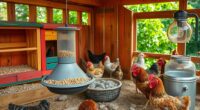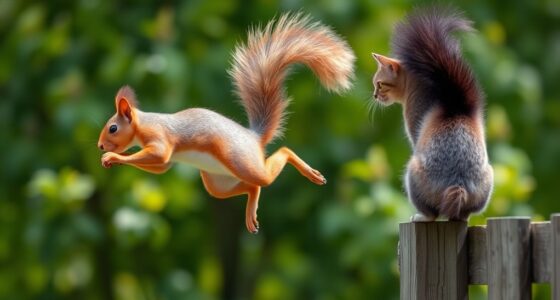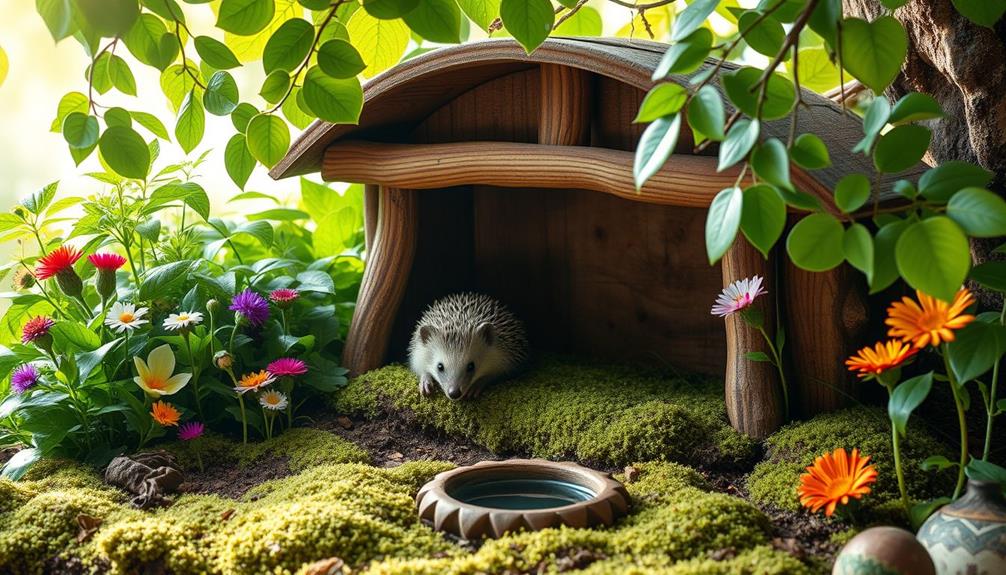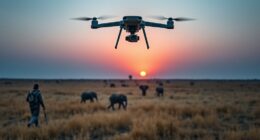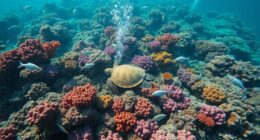In a penguin colony, you'll find a vibrant social structure where thousands of birds live together, forming strong pair bonds and cooperative breeding habits. Vocalizations play an essential role in communication, helping them identify mates and alerting the group to dangers. Parents share responsibilities in nurturing their rapidly growing chicks, adapting to environmental challenges like climate change and habitat loss. If you're curious about how these factors shape their lives, you'll discover even more intriguing details ahead.
Key Takeaways
- King penguin colonies are structured in a loosely hexagonal arrangement, with approximately 53% of individuals having six direct neighbors.
- Vocalizations play a crucial role in mating, chick recognition, and alarm calls, facilitating effective communication within the colony.
- Penguins form strong monogamous pair bonds, reinforced through courtship rituals, but may copulate with multiple partners during the breeding season.
- Both parents share incubation duties and care for chicks, feeding them for about 30 days until they can fend for themselves.
- Environmental challenges, including climate change, threaten penguin habitats, prompting conservation efforts like habitat protection and community education programs.
Colony Structure and Size

In the vibrant world of king penguins, colony structure and size play crucial roles in their social dynamics.
You'll notice that these colonies often exhibit a loosely hexagonal arrangement, with most penguins surrounded by six neighbors. About 53% of them have six direct neighbors, fostering a sense of community.
In king penguin colonies, a hexagonal arrangement fosters community, with over half surrounded by six neighbors.
The core of the colony tends to be more homogeneous and less dense than the borders, where breeding adults are separated from non-breeding birds. Additionally, the importance of research writing can be seen in understanding the complexities of these colonies, as it helps document and communicate findings effectively.
King penguin colonies can be massive, with several hundred thousand breeding pairs, primarily found on sub-Antarctic islands like South Georgia and the Crozet Islands.
Their preferred habitats are level grounds near the sea, influencing their distribution and stability considerably.
Breeding and Mating Practices
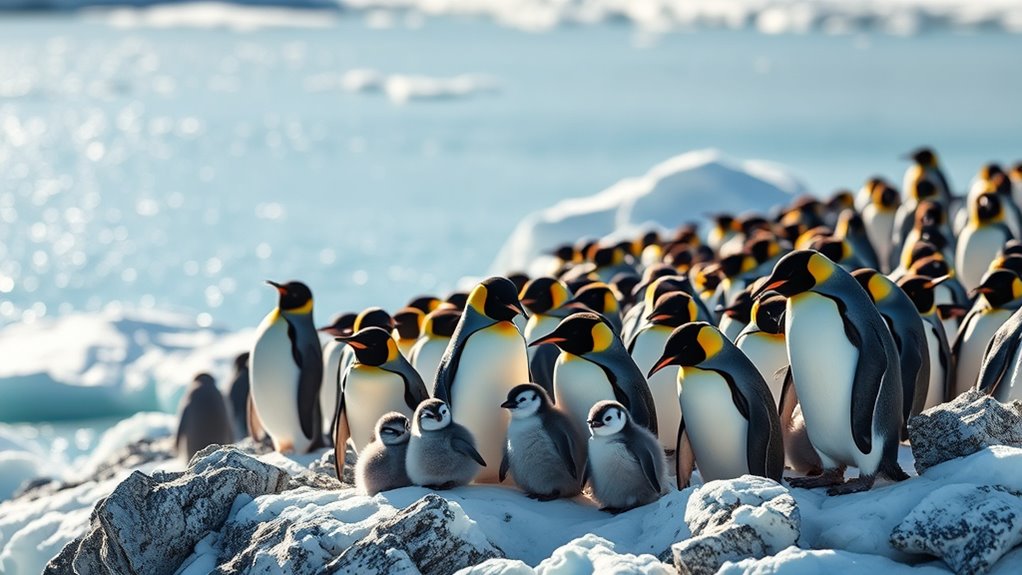
As you observe a penguin colony, you'll notice the strong monogamous pair bonds that form between mates. Courtship rituals, including elaborate displays and vocalizations, play a key role in solidifying these connections. This unique behavior not only enhances their bond but also sets the stage for successful breeding. During the breeding season, increased territorial behaviors can also be observed as penguins establish their nesting sites.
Monogamous Pair Bonds
While penguins are known for their social monogamy, their breeding and mating practices reveal a complex landscape of relationships.
You'll find that most penguin species return to the same partner yearly, though fidelity rates can differ markedly. Galapagos penguins boast high fidelity, while Emperor penguins show low fidelity. Penguins are not sexually monogamous; many engage in copulation with multiple partners during a breeding season.
Environmental factors and previous breeding success often influence whether they stay with their mates. Notably, some species, like Little Penguins, experience high divorce rates, reaching up to 50%.
Penguins choose mates based on breeding success and territory quality, and they often return to the same nesting sites.
Ultimately, these pair bonds are essential for raising chicks in harsh environments, showcasing a fascinating blend of strategy and adaptability.
Courtship Rituals and Displays
Building on the strong monogamous pair bonds penguins form, their courtship rituals and displays play a significant role in attracting and reinforcing these connections.
You might witness ecstatic displays, where penguins raise their chests and call loudly to draw in a mate. Pairs engage in mutual displays, rubbing their heads together to strengthen their bond.
Gentoo penguins bow, trembling their heads while producing soft growls. Males also impress females by offering stones or twigs for nest building. Galapagos penguins are monogamous and often engage in affectionate behaviors during courtship.
When they mate, males gently nibble on females' neck feathers while balancing carefully. These behaviors often unfold during the breeding season, near nesting sites, and are influenced by environmental factors like food availability, showcasing their adaptability and social nature.
Parental Care and Offspring Development

In penguin colonies, parental care plays an essential role in the survival and development of offspring. Males arrive first at breeding sites, establishing territories and building nests while fasting. Once females lay their eggs, they head to sea, leaving males to incubate. Both parents share incubation duties, ensuring continuous care for their eggs. Males' ability to endure fasting is crucial, as steady pitch in calls reflects their fitness and parenting potential.
After 38 to 42 days, chicks hatch and grow rapidly, gaining about 10% of their body weight daily. Parents feed them until they can fend for themselves. Chicks stay with their parents for about 30 days before leaving the nest, entering a critical learning phase. In some species, like Galapagos penguins, parents continue to feed fledglings, helping them learn essential survival skills.
Communication and Social Interaction
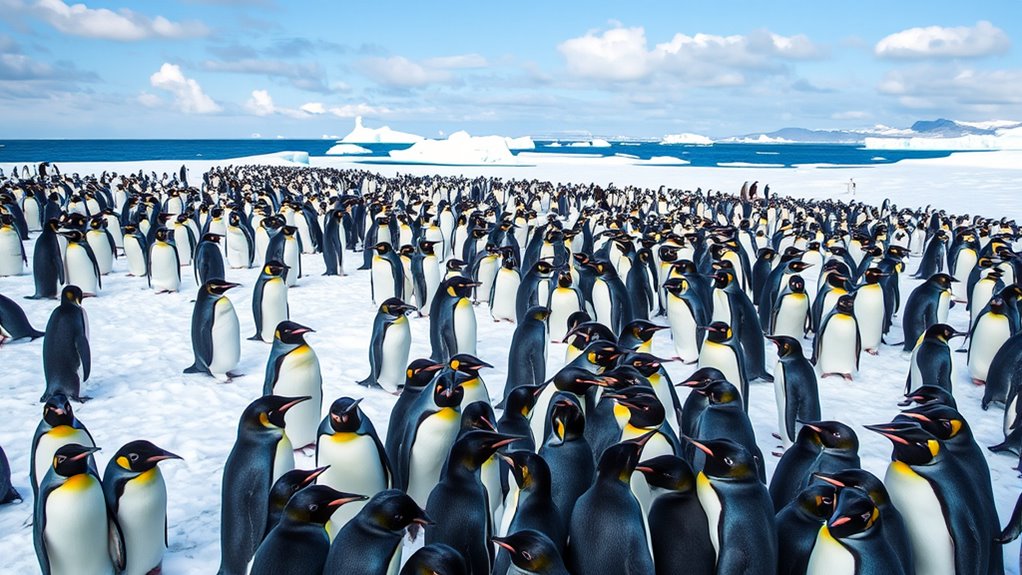
In a penguin colony, communication plays a crucial role in their social interactions. You'll notice how they use unique vocalizations and body language to build bonds and maintain group cohesion. Additionally, living in large colonies allows them to reduce the risk of predation and enhances their overall survival. Understanding these dynamics gives you a clearer picture of their complex social life.
Vocalizations and Calls
How do penguins stay connected in the bustling chaos of their colonies? They rely on a rich variety of vocalizations.
Contact calls help you identify fellow colony members, while threat vocalizations warn of predators and defend your territory. During courtship, specialized mating calls attract mates, and unique sounds allow both parents and chicks to recognize each other amidst the noise. Vocalizations are emitted through specialized throat structures that vary by species, allowing for distinct calls.
Each species has its own distinct calls—from the braying of African penguins to the two-sound system used by Emperor and King penguins.
Environmental factors, like habitat variations and noise levels, influence these vocalizations, ensuring that penguins can effectively communicate for social interaction, individual identification, and survival in their dynamic community.
Body Language Signals
Penguins don't just rely on their vocalizations for communication; they also express a wealth of information through body language.
You'll notice that visual displays play an essential role in their social interactions. Flapping or waving their flippers signals excitement or calls for attention. Specific postures can indicate aggression, courtship, or submission. In addition to these displays, their contact calls are vital for maintaining social bonds within the colony, helping them locate mates and chicks among large groups.
When you see a penguin bending or shaking its head, it's likely conveying rejection or interest. Grooming, or feather preening, shows relaxation and strengthens social bonds.
Keep an eye out for aggressive postures, like standing upright or spreading flippers, to deter intruders. These non-vocal cues are critical for maintaining harmony within the colony, allowing penguins to communicate effectively without a single sound.
Social Bonding Dynamics
While observing a penguin colony, you'll quickly notice the intricate social bonding dynamics that shape their interactions.
Penguins rely on distinct vocalizations for mating, chick recognition, and alarm calls, each serving multiple purposes. You'll see how species-specific calls help them identify one another, ensuring effective communication. Alarm calls alert the colony to potential threats, prompting quick responses from the group.
Dominant individuals assert their status through aggressive behaviors, influencing resource allocation and breeding opportunities within the social hierarchy.
Cooperative breeding enhances chick survival rates, as members share responsibilities and strengthen social bonds. You might also witness playful behaviors among young penguins, which foster social skills and community ties.
Through mutual grooming and vocalizations, pair bonds form, solidifying long-term commitments essential for successful breeding.
These dynamics create a vibrant, interconnected colony.
Environmental Adaptations and Challenges

Given their unique environment, penguins have evolved remarkable adaptations that help them thrive in some of the planet's harshest conditions. You'll find these characteristics fascinating:
- Thermal Insulation: Thick layers of blubber and dense feathers keep them warm in frigid temperatures.
- Streamlined Bodies: Their shape allows efficient swimming, helping them catch prey quickly and dive deep.
- Social Behavior: By forming large colonies, they enhance foraging success and improve predator avoidance. Adélie Penguins can form breeding colonies with hundreds of thousands of individuals, highlighting their strong social structure.
Yet, these adaptations face challenges. Climate change brings reduced sea ice, affecting breeding and food availability. Increased storms threaten their habitats, while shifts in ocean conditions disrupt krill populations, essential for their diet.
Climate change and shifting ocean conditions pose significant threats to penguins' survival and food sources.
Penguins must navigate these environmental hurdles to survive and thrive in their colonies.
Conservation Efforts and Future Outlook
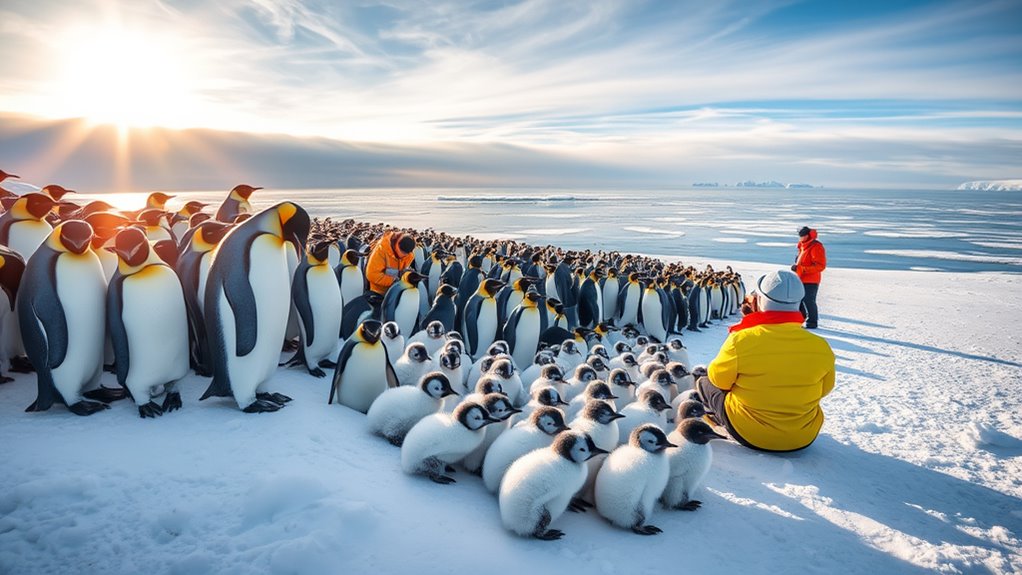
As climate change and habitat loss threaten penguin populations, conservation efforts are more important than ever. You can play a role in these initiatives by supporting habitat protection through artificial nest boxes and predator control measures. Organizations are continuously monitoring penguin behavior and dynamics, which helps refine conservation strategies. By participating in community education programs, you raise awareness about penguins' struggles and successes. Consider joining volunteer opportunities or citizen science projects, where your photos contribute to essential research. Successful stories, like the resurgence of breeding penguins on Phillip Island and efforts at the Oamaru Blue Penguin Colony, inspire hope. Protection efforts such as providing nesting boxes and trapping introduced predators are crucial in safeguarding these adorable creatures. However, ongoing challenges like climate change and habitat loss persist, making your involvement critical for penguins' future.
Frequently Asked Questions
How Do Penguins Find Their Way Back to Colonies?
When you're trying to find your way back to your colony, you rely on several cues.
You use visual landmarks and familiar pathways, especially in dense areas. Acoustic signals from your mates help guide you, while sometimes you might even pick up on smells.
If you're a Magellanic penguin, you'll follow specific paths that make your journey easier.
What Predators Threaten Penguin Colonies the Most?
Have you ever wondered what dangers lurk around penguin colonies?
Predators like leopard seals and orcas pose significant threats at sea, while on land, southern giant petrels and skuas target vulnerable chicks and eggs.
These threats can lead to alarming population declines and disrupt their breeding habits.
It's essential to understand these risks, as they challenge penguins' survival and highlight the need for effective conservation strategies to protect these remarkable birds.
Can Penguins Survive in Warmer Climates?
Yes, penguins can survive in warmer climates, but they face challenges.
You'll notice they adapt their behaviors, like panting and altering their postures to cool down. Some species, like Galapagos penguins, even pause breeding during extreme heat to protect themselves.
However, rising temperatures can disrupt their food supply and habitats, leading to population declines.
Protecting these remarkable birds means addressing climate change and ensuring their environments remain suitable for survival.
How Long Do Penguins Typically Live?
Imagine a penguin standing on the icy edge, its fate hanging in the balance.
You'll find that penguins typically live between 15 and 20 years in the wild, though some species, like the Magellanic penguin, can reach up to 30.
In captivity, they often thrive longer, sometimes living between 20 and 34 years.
Yet, factors like climate change and food availability could drastically alter their lifespans, leaving their future uncertain.
What Do Penguins Eat in the Wild?
In the wild, penguins primarily eat krill, fish, and squid, depending on their species and location.
If you observe them, you'll notice that larger penguins like the Emperor focus on fish, while those in colder climates rely heavily on krill.
Penguins often hunt in groups and dive to impressive depths to catch their prey.
They adapt their diet based on seasonal and geographical food availability, ensuring they meet their nutritional needs.
Conclusion
As you learn about the life of a penguin colony, you can't help but feel a profound connection to these remarkable creatures. Every time you watch a parent care for its chick or witness their intricate social bonds, you realize their survival hinges on both community and resilience. However, climate change threatens their icy homes. If we don't act now, the future of these colonies might be nothing but a memory, reminding us of what we've lost.

